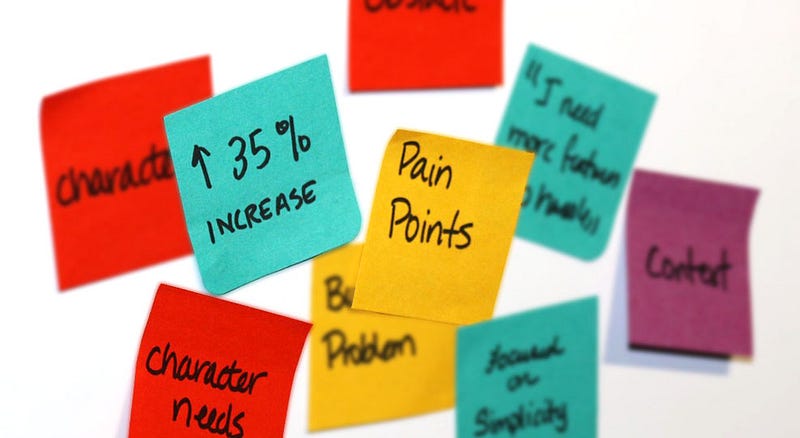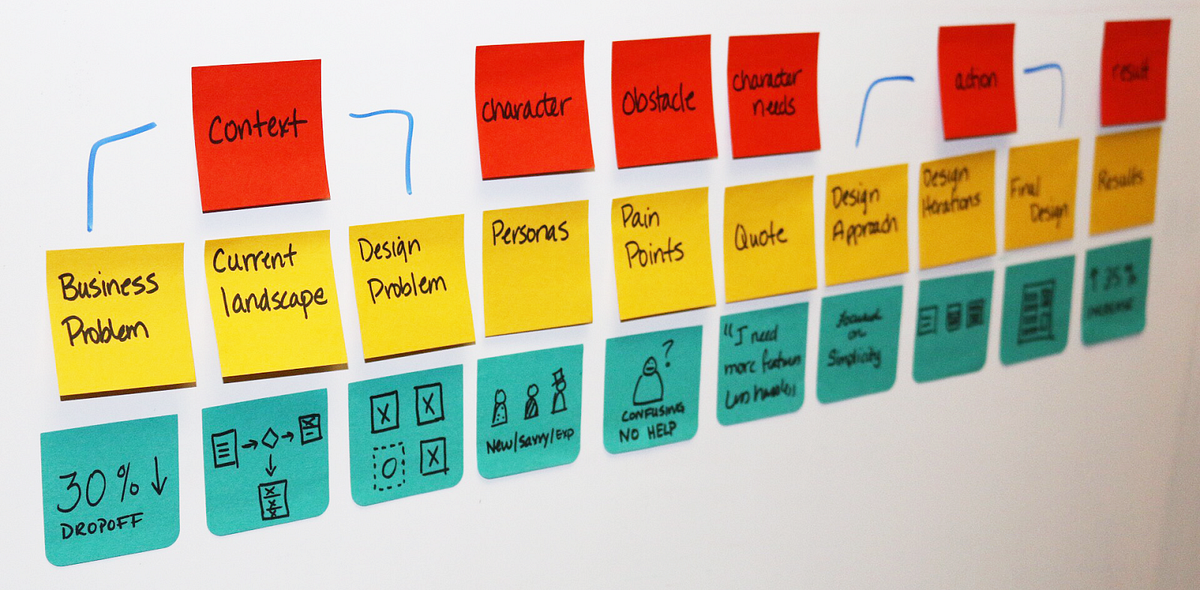In UX: Organizing content for maximum impact
The second post of a three part series on how to use UX storytelling to build influence
The second post of a three part series on how to use UX storytelling to build influence

A few years ago, I was working on a high profile project, and was asked by my manager to “put together a few slides” to show the progress of the project to a key stakeholder. I quickly put together a few screenshots of the UI, and a few bullets around the outcome we were expecting. I presented to the room, and in the middle of my presentation, the stakeholder interrupted — “No, this is the wrong direction.”
I immediately knew what I had done wrong. I didn’t set the context on how I arrived at that design, and instead I focused on the solution. The design had undergone three rounds of research, and three different iterations, but after that meeting, the project was deprioritized. The painful, but important lesson was to never squander the opportunity to tell a story.
Treat every presentation as a chance to build influence by sharing your ideas, expertise, and communicating across your organization. In my previous post, I highlighted that people remember stories, and stories follow a familiar arc. Organizing your content as a story will increase the likelihood of your presentation being remembered.
In the cross-functional nature of our role as UX Designers, we often present to multiple stakeholders at various levels, and these presentations focus on the following topics or formats:
- Creating a vision for a future product or design solution
- Project updates or key milestones on a project
- New ideas or proposals
- Design reviews
- Executive reviews
Stakeholders in these meetings typically include product managers, marketing managers, engineers, content writers, and other designers. Ideally, your presentation will cover questions and concerns your audience will have.
For example, if you are presenting to product managers, you will want to highlight how your solution maps to larger business objectives. The goal is to ensure that your presentation appeals to the audience within the context of a larger story framework.
To help illustrate the story framework, Paul Smith’s book Lead with a Story, highlights that the key elements of a story are context, character, character needs, obstacle, action, and result. In my experience, most presentations in the corporate setting jump right into action and results, which is the same trap I fell into in the story I shared above.
Using Smith’s story elements, you can start discovering the story in your content by capturing the main ideas of the story on a sticky note. The sticky notes represent the takeaways you want the audience to grasp from your story. Think of the sticky note as a placeholder for a slide, with the focus of one slide per key point.
Distilling your message into its simplest form will uncover the most important parts of the message that need to be communicated and understood. Think about how you would explain it to someone who doesn’t know anything about the work you do, and usually this is where the main ideas are.
In Nancy Duarte’s book on this topic, Slide:ology, she advocates for using sticky notes to ideate and brainstorm the content for your presentation. This helps you start planning your content in smaller, more digestible chunks, which will be much easier for your audience to grasp.
If you are challenged to come up with your key points, ask yourself some of the following questions which map to the story structure:
(Context) What business problem were you trying to solve?
(Context) What are some market/industry trends in this space?
(Context) Is there any previous user research to help inform your thinking?
(Context) Are there any interesting metrics or data around usage to inform your design?
(Character) Who is your user?
(Character needs) What needs does your user have that aren’t being met?
(Obstacle) What pain points did your users have in the current design?
(Obstacle) What would a day in the life of your user look like before and after your idea/process/vision?
(Obstacle) What were some of the constraints you were working within?
(Action) What were some of the other ideas, thoughts, conclusions reached based on your findings?
(Results) What is the expected outcome of the design/process or product execution?
(Result) Is there any feedback from the users on the approach?
(Result) Are there any data after the design went live?
Some of these questions might help you uncover a new way of thinking about your story.

Once you have your main ideas captured in the form of sticky notes, check to see if your ideas flow. Put your sticky notes on a wall to see if you’ve captured all the key takeaways of the story.
Treat every presentation as a chance to build influence by sharing your ideas, expertise, and communicating across your organization.
Once you feel comfortable with your key points, expand on your concepts. Your main idea is what you want the audience to take away, so you’ll need to fill in some detail for support the key point, so your audience understands your rationale. These details will start to make up what you will say during your presentation. Typically, I make a shorthand drawing on a separate sticky note of how I might want to layout that slide.
Next, you’ll want to determine how to transition from one slide to another. The sticky notes are your guide, start from the beginning, and think about how you want to bridge each slide, so that your transitions from each concept don’t seem abrupt.
Bridging statements help transition from one slide to the next, so that the flow of the story sounds more natural. Typically, writing this in a script format is helpful. In this example, I might want to write my script in a conversational tone like this:
Business Problem concept:
“As some of you might know, this year we were faced with a 30% drop off on our sign up flow.”
Once you know what you want to say about that slide concept, you can start to move into the next concept.
Design Problem concept:
“After looking at the flow in more detail, I noticed that the drop-off was in the form area. In this form area, we ask for multiple phone numbers and the form fields populated a lot of errors when users added dashes, which is normally how people type out their phone number. We also don’t give them in help in trying to fix this.”
Do this for each sticky note, until all sticky notes have been accounted for in your script.
This process might feel like a big investment, especially if you have never put a lot of effort into creating a story around your work. However, the power of a well-told story is partly rooted in a strong story structure, and the trade-off is well worth the time it takes initially to start thinking about your work as stories, and over time, you will get much faster at finding the stories in your work.
In the last article in this series, I’ll talk about presentation design.